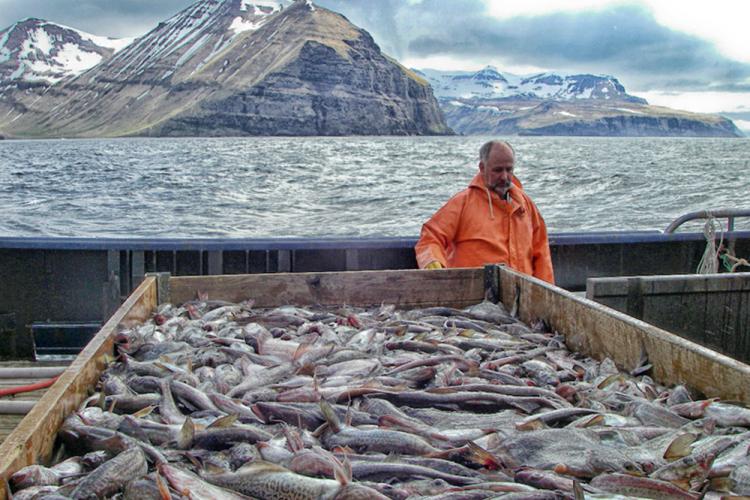Groundfish are, with some exceptions, fish that live on or near the ocean bottom. These include commercially and ecologically important species such as Alaska walleye pollock—target of the largest commercial fishery in the United States—Pacific cod, sablefish, and a variety of rockfish and flatfish species. Gulf of Alaska groundfish comprise 141 species; Bering Sea and Aleutian Islands, 148 species.
Our scientists determine how many fish there are, where they are, when, and at what age. We define species and stocks through systematics (the study of evolutionary relationships, which involves classifying and naming species) and genetics. We determine what habitats are essential for each species. We study how groundfish population health and survival are affected by human activities and environmental changes. We evaluate the social and economic aspects of fisheries to ensure that both fish populations and the communities that depend on them thrive.

A Dusky rockfish.
Stock Assessments
Annual North Pacific Groundfish Stock Assessment and Fishery Evaluation (SAFE) reports summarize the best available scientific information on the past, present, and possible future condition of Alaska groundfish. These reports incorporate assessments, economic status, and ecosystem considerations for each groundfish stock. SAFE reports provide the information fisheries managers need to set sustainable harvest levels.
Surveys
Bottom trawl surveys are the foundation for assessing many groundfish species, including Alaska walleye pollock, Pacific cod, and a variety of rockfishes and flatfish.
Annual longline surveys collect information on sablefish, Pacific cod, skate, and flatfish stocks. The longline survey also has one of the longest and most extensive tagging programs in the nation, providing a wealth of information about fish movements and mortality.
Midwater surveys combine trawls and acoustic echo integration technology to assess the population status of Alaska walleye pollock.

A Pacific Cod.
Observer Program
The North Pacific Observer Program plays a vital role in the management of Alaska groundfish fisheries. Over 450 observers annually collect catch data and biological samples onboard fishing vessels and at onshore processing plants. The information they provide is essential for stock assessments and ecosystem studies.
Identifying Species and Stocks
Our fish systematics research—describing, classifying, and determining evolutionary relationships among fish species—enables us to more accurately identify groundfish species.
Genetics research helps identify Alaska groundfish stocks, where they came from, what areas are important for their young, and when they cross borders. This information is required in regional, national, and international agreements and treaties on the management of groundfish.
Age and Growth
Knowing the age composition of commercially exploited fish populations is critical to understanding reproduction and mortality, predicting future population sizes, and setting sustainable catch limits. Our scientists derive fish age estimates by analyzing growth rings on otoliths (fish ear bones) or other structures like scales or vertebrae.

Early Life
Understanding how environmental factors limit survival of young fish is key to understanding future fish population productivity. To find out how well juveniles are navigating the perils of early life, we relate their nutritional status at different stages of development to environmental conditions. We study juvenile fish in the Gulf of Alaska, Bering Sea and Arctic.
Habitat
We identify habitats that contribute most to the survival, growth, and productivity of different groundfish species, and determine how to best manage and protect them from disturbance and environmental change.

Walleye pollock.
We look at how the relationship between fish behavior and environment influences the distribution and survival of groundfish species. We analyze fishing gear performance and study the stresses imposed on fish by fishing activity. This information is critical to help improve stock survival, survey techniques, and population abundance and distribution predictions.
Food Web Models
Our scientist collect and analyze fish diet data on interactions among groundfish and their predators, prey, and environment to create assessment models. Quantifying food web linkages is essential to understanding how external forces such as fishing may cause unanticipated shifts in the ecosystem. This research also provides insight into resource availability to marine mammals and birds.
Economic and Social Studies
We conduct research to provide the social and economic information needed to ensure the sustained participation of Alaska communities in groundfish fisheries. Each year we produce an Economic Status Report that summarizes available economic data about the federal groundfish fisheries including statistics on catch, discards, prohibited species catch, ex-vessel and first-wholesale production and value, participation by small entities, and effort in these fisheries.
Ecosystem Monitoring
We conduct research to link environmental and climate change with changes in the growth, fitness, and survival of commercially important Alaska groundfish species. To accomplish this we collect information on ocean temperature, salinity, oxygen, nutrients, phytoplankton (tiny plants), zooplankton (tiny animals), and fish. Our research is incorporated in Alaska marine ecosystem status reports which provide scientific advice to manage and protect marine resources and human communities by supporting ecosystem-based fisheries management.
Additional Resources
- Alaska Groundfish Survey Data Map
- Habitat Research in Alaska
- Connecting Independent Research Surveys of Bering Sea Salmon Populations to Chum Salmon Bycatch in Bering Sea Groundfish Fisheries
Contact

